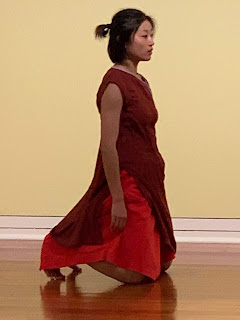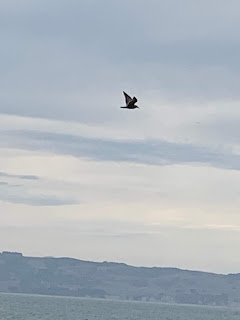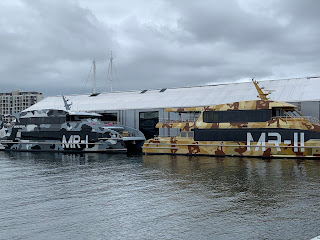Tuesday February 26 started cloudy, but the sun came out and the high got to 21C by late afternoon.
We walked into town and had an Allpress coffee at a café called The Good Oil. We also got a takeout B.L.A.T. sandwich to have later in the afternoon.
 |
| Our 10 minute walk into town, down this street (Pitt St.) |
 |
| Knox Church-- Dunedin has some beautiful churches. This church dates back to 1876, in the Gothic Revival style. It has a soaring 50m steeple. |
We decided to spend the late morning at the Dunedin Public Art Gallery, which is on one corner of the Octagon, the main "square" in Dunedin. It is kitty corner from the I-Site Visitor Centre, where we needed to be at 1:15 p.m. to meet our Monarch Wildlife tour and cruise.
 |
| Foyer of the Art Gallery |
We only had time to peruse the main floor of the gallery which featured works from the collection in an exhibit entitled:
World View: Mapping the Dunedin Public Art Gallery Collection. The paintings were grouped by country-- e.g. Japan, Australia, Europe, Britain and Aotearoa New Zealand [note that everywhere that New Zealand is mentioned in posters, signage etc it is written as Aotearoa New Zealand-- Aotearoa being the Māori word for the country].
The Art Gallery was founded in 1884 and moved to its present location in 1996.
 |
| Narcissus in a Storm - lithograph purchased in 1979 - Arthur Boyd (1920-1999-Australian) |
 |
| Nebuchadnezzar Running in the Rain -oil purchased 1968 -Arthur Boyd |
 |
| Lancashire Industrial Scene 1928- L.S. Lowry (1887-1976- English) |
 |
| Fair and gay goes Lent away 2005 Julia Morison (b. 1952) - New Zealand (we saw her wonderful ceramics in the Christchurch gallery) |
 |
| Earth Shield 1984- Claudia Pond Eyley (b. 1946 -New Zealand) |
 |
| Self Portrait 1937- Rita Angus (1908-1970 - New Zealand). Another NZ artist we really like. |
 |
| Portrait of Myfanwy Evans c. 1940 Frances Hodgkins (1869-1947- New Zealand) (From Dunedin) |
We were very fortunate to run into a free gallery performance by New Zealand Dance and Guangdong Modern Dance Company which featured an excerpt from
Hemispheres, an international collaboration that was going to be performed that evening at a local theatre. The dancers started in one gallery and then moved to another gallery. There were dancers from both New Zealand and China in the performance.
 |
| Dance in the galleries |
 |
| Moving to another gallery space |
The Dunedin Public Art Gallery is located on the Octagon as is the magnificat St. Paul's Cathedral. The main part of the church dates from 1919 although the sanctuary was left unfinished until 1971.
 |
| St. Paul's Cathedral |
 |
| Municipal Building |
There is a statue of Robbie Burns in the middle of the Octagon.
 |
| Robbie Burns statue |
There are also a number of plaques in the sidewalk honouring NZ writers. It is called Writers Walk. Dunedin became New Zealand's first UNESCO Creative City when it was awarded 'City of Literature' status in 2014. Dunedin is "well known as a university town of excellence in research and learning, and a city where writers, books and literature thrive".
 |
| Honouring Janet Frame (1924-2004), a Dunedin writer |
 |
| Another NZ writer on the Writers Walk |
At 1:15 p.m., we were picked up by a small shuttle bus run by Monarch Wildlife Cruises and Tours. The first part of our 5.5 hour adventure was a one-way bus trip up the beautiful Otago Peninsula. Our driver pointed out highlights and gave us a bit of history of the area. We first stopped at a series of stone teeth in the harbour just before we started our journey up the peninsula.
Harbour Mouth Molars are a set of six geologically-scaled wisdom teeth in the Otago Harbour installed in 2010. The Dunedin City Council commissioned the work. A number of artists had submitted designs for the project and the winner was selected by the city's art community. Wellington-based artist Regan Gentry won the contest. According to Gentry, the sculptures (which cost around $45,000 NZD), were designed not only to pay homage to the University of Otago's Faculty of Dentistry (NZ's only Dental school), which extracted his wisdom teeth, but also as a reminder of the volcanic origins of Dunedin's harbour, quarries and surrounding landscape.
 |
| Harbour Mouth Molars-- crafted from limestone, quartz, concrete and steel |
We started our drive when it was still cloudy--- lovely climb up the peninsula through the volcanic hills and farmland.
 |
| Starting up the peninsula |
 |
| Great sign on farm property |
 |
| Sun coming up on the farmland- view of ocean |
 |
| Lots of sheep |
 |
| There are a number of old volcanoes on the peninsula |
 |
| Big sheep through the bus window |
Our driver explained how the early settlers didn't realise the volcanic soils would erode quickly. They eventually imported trees that would stop the erosion.
 |
| Trees helping stop erosion |
We stopped near the top of the peninsula at Wellers Rock Wharf to pick up some passengers who had done the boat tour first. We would be doing the boat tour after we visited the penguins. We stopped for a few minutes, and some people saw a lost blue penguin under the wharf.
 |
| We would return here for the start of our boat trip |
Our bus continued to Penguin Place, a private Conservation Reserve that cares for rare Yellow Eyed Penguins. We would visit there for about 1.5 hours.
 |
| Arriving at Penguin Place |
We were first taken to a small classroom where the guide explained the life cycle of yellow eyed penguins. When they are young, they don't have the yellow iris or band of bright yellow running from their eyes around the back of their heads. For the first six weeks after hatching the chicks are guarded during the day by one parent while the other is at sea feeding. After six weeks of age, both parents go to sea to supply food to their growing offspring. The young penguins usually fledge (develop wing feathers that are large enough for flight) in mid-February and are totally independent from then on. This species of penguin is endangered and is considered one of the world's rarest penguin species.
Our guide also explained that penguins moult all their feathers at once and that it takes about 3-4 weeks, typically beginning in February for juveniles and March/April for adults. During the moult, because the plumage is not waterproof at that time, the penguins can't go to sea to feed and may lose 3 to 4 kg in weight. They are confined to shore as they wait for their old feather coat to be replaced. There is threat of starvation and dehydration and they are unable to escape easily from predators.
 |
| The penguin cycle |
After the talk, our guide took us to their Rehabilitation Centre to see the penguins. The Rehab facility has been in operation since the early 1990s. In recent years, the facility has been very busy. Each year, about 90% of the penguins brought into rehab will survive to be released. The main cause for penguins requiring rehab varies from season to season, but common causes are starvation, orphaned chicks and predator injuries. Our guide said it is getting harder for their parents to find enough food for their young, so they are often found malnourished. They don't stay in the rehabilitation facility for too long, and once healthy are let out into the wild again. There were quite a number of penguins there right now. Most are yellow eyed penguins but there are other species of penguins that are brought there for rehab.
 |
| Young yellow-eyed penguins |
 |
| On the mend |
 |
| Sunning themselves |
 |
| Love this pose |
 |
| A moulting penguin |
 |
| A different specie |
 |
| Gorgeous |
 |
| Time for dinner please |
 |
| Hanging around in the sun |
After seeing the penguins in the rehabilitation facility, we were taken in a bus by our guide to the Penguin Place reserve near the sea, to see if we could view any of the penguins in their natural habitat. Our guide pointed out other native birds, fur seals and a beautiful native forest.
 |
| Gorgeous seashore |
 |
| Large birds |
 |
| Fur seals sunning themselves |
 |
| More seals |
We then walked to a trench entrance, where we entered to view some birds that were in the moulting stage and had to stay on land.
 |
| Walking along the trench |
 |
| Moulting bird |
 |
| Another yellow-eyed penguin |
 |
| More views |
It was a fascinating visit--- the Penguin Place is doing great work in rescuing these rare penguins. After our visit, the guide drove us to the wharf, were we got on a boat for a Wildlife Cruise around Taiaroa Head, the world's only mainland breeding colony of Royal Albatross. The large albatrosses have a three metre wingspan. Taiaroa Head is home to over 20 species of wildlife.
 |
| Hard to get pics, but we tried |
 |
| What wingspans! |
 |
| We also saw fur seals |
 |
| This was another Monarch Tour boat that we passed- we were on a similar boat |
 |
| Almost got the full wing span--- totally amazing |
 |
| Over the lighthouse |

 |
| Alain on the boat- it wasn't that cool- but they gave us big jackets to wear as well as binoculars |
 |
Taking a pause
We were in luck to pass near a fishing boat--- lots of birds flying near by, hoping to get some discards of fish.
|

 |
| Fishing boat attracted a lot of albatrosses and other birds |
 |
| Largest bird is a Royal eating a fish |
 |
Looking up at the lighthouse and point where birds congregate
(lighthouse dates back to 1863, during Dunedin gold rush days) |
 |
| Windblown selfie-- thrilled to see all the wonderful albatrosses and other birds |
The last part of our tour was a cruise back into town. We had two knowledgeable guides on the boat- one gave commentary that was broadcast on a speaker--- when he spotted some dolphins, the boat did a small circle as we looked for them. There was another guide on deck that we chatted to about what we were seeing.
 |
| The coast |
We passed a huge Cruise ship--- it's emissions were responsible for a haze we saw earlier in the day.
 |
| Cruise ship in Dunedin harbour-- they now get around 120 ships a year-- big business for the locals |
 |
| Port of Dunedin |
 |
| Lots of logs from plantation forests going to Asia |
 |
| Subdivisions on the hill-beautiful setting |
 |
| Kiwi Rail passing by |
 |
| Kayakers |
 |
| We passed the large stadium built for Rugby and now often used for concerts (Eagles coming in early March) |
We landed and then were taken by bus the short distance to the I-Site Visitor Centre. It was an incredible day. Tourism is done so well in NZ and we had a wonderful experience at the Penguin Place (conservation done so well and respectfully) and the chance to see Royal Albatrosses and other wildlife we have never seen before. We missed the small blue penguins, but they usually come out at night and we didn't want to do a tour that would get back so late.
We decided to have dinner at Best Cafe, which has been serving fish and chips since 1932. We tried some blue cod and tarakihi, a fish we have enjoyed earlier in our trip.
 |
| Sign for Best Cafe |
 |
| Through the window |
 |
| Alain with his fish and chips and local beer |
 |
| Classic local restaurant |
 |
| Chatting at the cash register |
We headed back to the apartment. What a day!!































































































Comments
Post a Comment